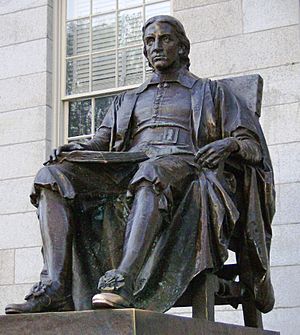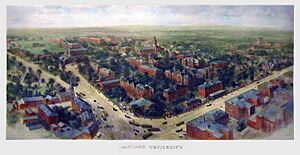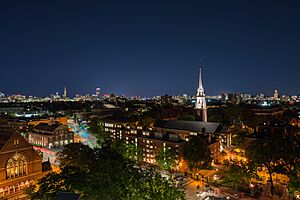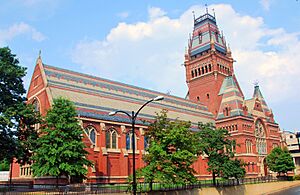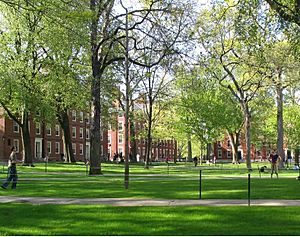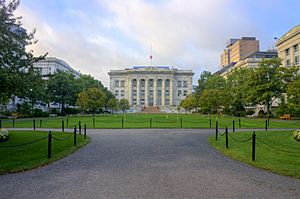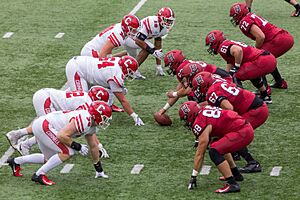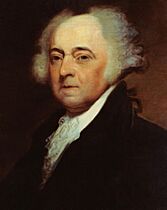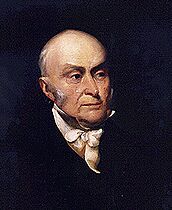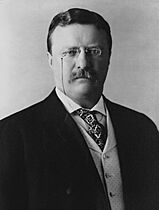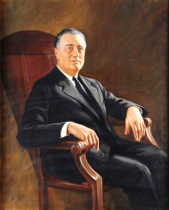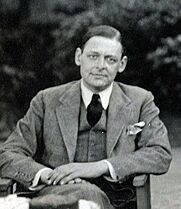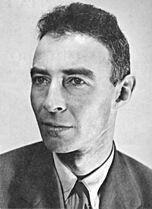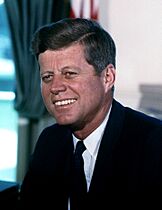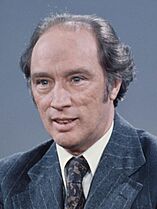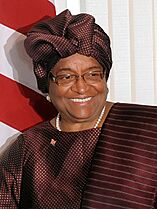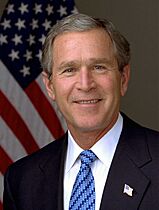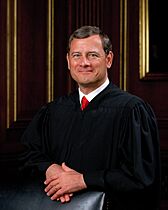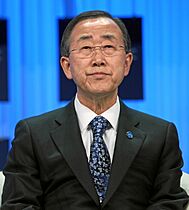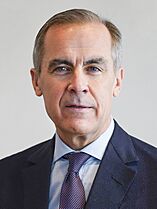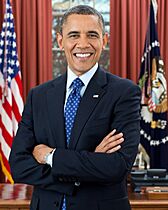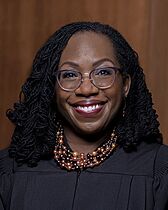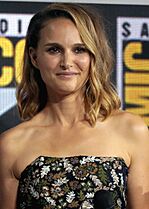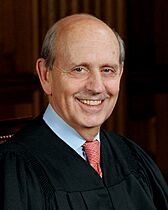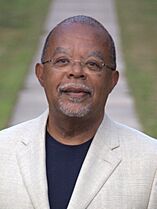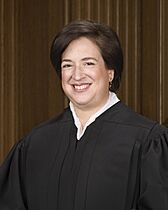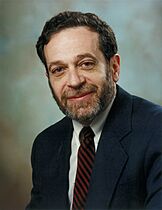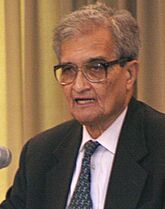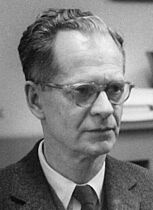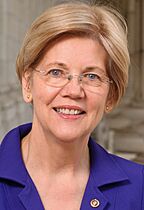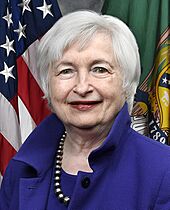Harvard University facts for kids
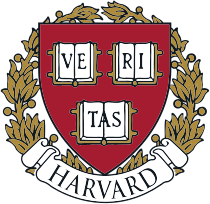
Coat of arms
|
|
| Latin: Universitas Harvardiana | |
|
Former names
|
New College Harvard College |
|---|---|
| Motto | Veritas (Latin) |
|
Motto in English
|
"Truth" |
| Type | Private research university |
| Established | October 28, 1636 |
| Founder | Massachusetts General Court |
| Accreditation | NECHE |
|
Academic affiliations
|
|
| Endowment | $53.2 billion (2024) |
| President | Alan Garber |
| Provost | John F. Manning |
|
Academic staff
|
~2,400 faculty members (and >10,400 academic appointments in affiliated teaching hospitals) |
| Students | 21,189 (fall 2024) |
| Undergraduates | 7,038 (fall 2024) |
| Postgraduates | 14,151 (fall 2024) |
| Location |
,
United States
42°22′28″N 71°07′01″W / 42.37444°N 71.11694°W |
| Campus | Midsize city, 209 acres (85 ha) |
| Newspaper | The Harvard Crimson |
| Colors | Crimson, White, and Black |
| Nickname | Crimson |
|
Sporting affiliations
|
|
| Mascot | John Harvard |
 |
|
Harvard University is a private research university in Cambridge, Massachusetts. It is part of the Ivy League, a group of famous universities. Harvard was started in 1636 as New College. It was later named after John Harvard, a clergyman who gave money and books to the school. Harvard is the oldest university in the United States. It is known worldwide for its influence, wealth, and high rankings.
Harvard was created by the government of the Massachusetts Bay Colony. In its early years, it trained many religious leaders. Over time, it became more open to different studies and students.
By the 1800s, Harvard was a very important school in Boston. After the American Civil War, it grew into a modern research university. It added many professional schools. Harvard also helped start the Association of American Universities in 1900.
The university has ten main academic departments. It also has a special department linked to the Harvard Radcliffe Institute. Harvard offers many different subjects for both undergraduate and graduate students. It has three main campuses:
- The main campus in Cambridge, which is about 209 acres.
- A campus in Allston, Boston, right across the Charles River.
- A medical campus in Boston's Longwood Medical Area.
Harvard has the largest university fund in the world, worth about $53.2 billion. Its library is also the world's largest university library, with over 20 million books. Many famous people have studied or taught at Harvard. This includes U.S. presidents, Nobel Prize winners, and founders of major companies.
Contents
Harvard's History
Early Years
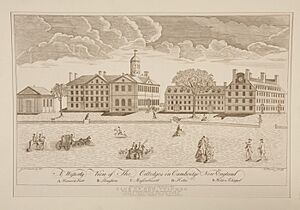
Harvard was founded in 1636 by the government of the Massachusetts Bay Colony. Its first leader was Nathaniel Eaton. In 1638, the university got the first printing press in English North America. That same year, John Harvard, a religious leader, left the college money and his library. The college was then named Harvard College.
In 1643, Harvard said its goal was to "advance learning." It wanted to make sure there would always be educated leaders for churches. In its early days, Harvard trained many religious ministers. It taught a classic curriculum, like universities in England. Harvard never officially belonged to one church. However, its teachings followed Puritan beliefs.
In 1708, John Leverett the Younger became Harvard's first president who was not a clergyman. During the American Revolution, Harvard's teachers and students supported the American side.
Harvard's first official seal, from 1650, showed three open books. It had the motto "IN CHRISTI GLORIAM," meaning "To the glory of Christ." This showed the school's original religious purpose. Later, in 1885, a new seal was made. It featured three open books with the motto "VERITAS" (Truth). Around it was "CHRISTO ET ECCLESIÆ" (For Christ and the Church). This seal combined learning with the university's religious roots.
The 1800s
In the 1800s, new ideas about reason and free will influenced Harvard. These ideas were common among some religious leaders. In 1805, Henry Ware was chosen for a key teaching role. In 1807, Samuel Webber became president. This showed a shift towards more modern ideas at Harvard.
In 1816, Harvard started new language programs. It began teaching French and Spanish. George Ticknor became the first professor for these programs.
From 1869 to 1909, Charles William Eliot was Harvard's president. He made the curriculum more flexible. Students could choose more of their own courses. He also made the university less focused on Christianity. By the late 1800s, Harvard's graduate schools began to accept women.
The 1900s
In 1900, Harvard helped create the Association of American Universities. For many years, most Harvard students came from wealthy Protestant families.
Throughout the 1900s, Harvard's reputation grew. It became one of the world's most respected universities. More smart teachers joined the school. The number of students also grew a lot. This was because new graduate programs were started. The undergraduate college also expanded. Radcliffe College became a top school for women. It was linked to Harvard College.
Between 1933 and 1953, James B. Conant led Harvard. He worked to make Harvard a leader in research. He believed that higher education should be for talented students, not just the wealthy. He created programs to find and support bright young people. In 1945, women were first allowed into the Harvard Medical School.
After World War II, Harvard changed its admissions. It wanted to accept a wider range of students. Special exams were made for veterans. The college started accepting more middle-class students from public schools. More Jewish and Catholic students were admitted. Over the second half of the 1900s, Harvard became more diverse.
From 1971 to 1999, Harvard managed Radcliffe's women students. In 1999, Radcliffe officially became part of Harvard University.
The 2000s
On July 1, 2007, Drew Gilpin Faust became Harvard's first female president. She retired in 2018. Lawrence Bacow then became the 29th president.
In July 2023, Claudine Gay became Harvard's 30th president. She was a professor at Harvard. In January 2024, she resigned. Alan Garber, the university's provost, became the interim president. In August 2024, Garber was named Harvard's 31st president.
Harvard's Campuses
Cambridge Campus

Harvard's main campus is about 209 acres. It is in Cambridge, Massachusetts. This is about three miles from downtown Boston. The campus is centered around Harvard Yard. The Yard has several Harvard buildings. These include four of the university's libraries: Houghton, Lamont, Pusey, and Widener.
Also in Harvard Yard is Massachusetts Hall. It was built between 1718 and 1720. It is the university's oldest building still standing. Other buildings include Memorial Church and University Hall.
The Yard also has main academic buildings for arts and sciences. These include Sever Hall and Harvard Hall. Freshman students live in dorms here. Older students live in twelve residential houses. These houses are near the Charles River and on Radcliffe Quadrangle. Each house is a community with its own dining hall and library.
Other schools on the Cambridge campus include Law, Divinity (theology), Engineering, Design (architecture), Education, and Kennedy (public policy).
Allston Campus
Harvard Business School and many sports facilities are in Allston, Boston. This campus is about 358 acres. It is across the Charles River from Cambridge. The John W. Weeks Bridge connects the two campuses.
Harvard is growing in Allston. It owns more land there than in Cambridge. New buildings are planned for the Business School. There will also be a hotel, student housing, and sports facilities.
In 2021, the Engineering and Applied Sciences school expanded into a new complex in Allston. This complex is designed to help new technology and life science companies.
Longwood Campus
Harvard's Medical, Dental, and Public Health schools are in Boston. They are on a 21-acre campus in the Longwood Medical and Academic Area. This is about 3.3 miles south of the Cambridge campus.
Several hospitals and research centers are also in Longwood. These are connected to Harvard. They include Boston Children's Hospital and Brigham and Women's Hospital.
Other Locations
Harvard also owns other places. These include a research library in Washington, D.C., and a forest in Massachusetts. It has a research center in Florence, Italy, and one in Greece. There is also a Harvard center in Shanghai, China.
How Harvard is Run
Leadership
Harvard is run by two main groups: the Harvard Board of Overseers and the President and Fellows of Harvard College. These groups choose the President of Harvard University.
Harvard has about 16,000 staff and teachers. This includes 2,400 professors.
University Funds
Harvard has the largest university fund in the world. It was worth about $50.7 billion in 2023. This money helps fund the university's operations. About $2 billion from investments is used each year.
During the economic downturn of 2007–2009, Harvard's fund lost money. This caused budget cuts. But the fund has since grown back. The fund's performance is very important. It helps pay for degrees and financial aid. Only about 22% of Harvard's money comes from student tuition and fees.
Students have sometimes asked Harvard to stop investing in certain companies. For example, they asked Harvard to stop investing in companies linked to apartheid in South Africa. They also asked about fossil fuel companies. Harvard has sometimes changed its investments because of these requests.
What Students Learn
| School | Founded |
| Harvard College | 1636 |
| Medicine | 1782 |
| Divinity | 1816 |
| Law | 1817 |
| Engineering | 1847 |
| Dental Medicine | 1867 |
| Graduate Arts and Sciences | 1872 |
| Business | 1908 |
| Extension | 1910 |
| Design | 1936 |
| Education | 1920 |
| Public Health | 1913 |
| Government | 1936 |
Harvard is a large university with many students living on campus. It offers 50 different majors for undergraduate students. It also has 134 graduate degrees and 32 professional degrees. In the 2018–2019 school year, Harvard gave out many degrees.
Harvard College is the four-year program for undergraduate students. It focuses on arts and sciences. Students usually take four classes each semester. To get an honors degree, students take advanced classes and write a big paper.
Some introductory classes are very large. But most classes have about 12 students.
The Harvard Faculty of Arts and Sciences is the largest department. It teaches students in Harvard College and other graduate schools. There are nine other graduate and professional schools.
Harvard also has four joint programs with MIT. These include programs in health sciences and technology.
Professional Schools
Harvard has 12 professional schools. These schools offer specialized degrees.
| School | Founded | Enrollment |
|---|---|---|
| Medicine | 1782 | 660 |
| Divinity | 1816 | 377 |
| Law | 1817 | 1,990 |
| Dental Medicine | 1867 | 280 |
| Graduate Arts and Sciences | 1872 | 4,824 |
| Business | 1908 | 2,011 |
| Extension | 1910 | 3,428 |
| Design | 1914 | 878 |
| Education | 1920 | 876 |
| Public Health | 1922 | 1,412 |
| Government | 1936 | 1,100 |
| Engineering | 2007 | 1,750 (including undergraduates) |
Research at Harvard
Harvard is a top research university. It is known for "very high" research activity. It offers many doctoral programs in arts, sciences, engineering, and medicine.
The Harvard Medical School is often ranked first for research. Biomedical research is a special strength. More than 11,000 teachers and 1,600 graduate students do research there. In 2019, the medical school received $1.65 billion in research grants. This was more than double any other university.
Harvard Libraries
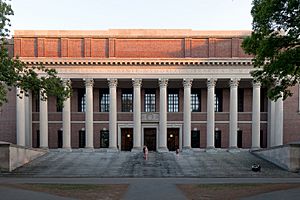
Harvard Library is the largest university library in the world. It has over 20.4 million items. Its main building is Widener Library in Harvard Yard. The system includes 25 libraries around the world. It has more than 800 librarians.
Houghton Library and the Harvard University Archives have rare and unique materials. The oldest collection of maps in the U.S. is in Pusey Library. It is open to the public. The largest collection of East Asian language materials outside of East Asia is in Harvard-Yenching Library.
Other important libraries include Baker Library at the Business School. There is also the Cabot Science Library.
Harvard Museums
Harvard Art Museums include three museums. The Arthur M. Sackler Museum has Asian, Mediterranean, and Islamic art. The Busch–Reisinger Museum shows European art. The Fogg Museum has Western art from the Middle Ages to today.
Harvard Museums of Science and Culture include the Harvard Museum of Natural History. This museum has the Harvard Mineralogical Museum and the Glass Flowers exhibit. Other museums include the Harvard Collection of Historical Scientific Instruments. The Peabody Museum of Archaeology and Ethnology focuses on cultures of the Western Hemisphere.
Harvard's Reputation
| ARWU World | 1 |
|---|---|
| THES World | 3 |
| USNWR National University | 3 |
| Washington Monthly National University | 1 |
| Forbes | 8 |
Harvard University is officially recognized by the New England Commission of Higher Education. Since 2003, the Academic Ranking of World Universities has ranked Harvard first in the world. The Times Higher Education World University Rankings has also ranked Harvard first since 2011.
Harvard is often ranked among the top universities in the U.S. It is in the first group with Columbia, MIT, and Stanford.
Harvard also ranks high in specific areas. It was first in a ranking that looked at how many alumni became CEOs of major companies. According to polls, Harvard is often named a "dream college" for students and parents.
In 2019, Harvard's engineering school was ranked the third-best in the world. In international relations, Foreign Policy magazine ranks Harvard best for undergraduate studies.
| Race and ethnicity | Total | ||
|---|---|---|---|
| White | 33% |
|
|
| Asian | 22% |
|
|
| International student | 14% |
|
|
| Hispanic | 12% |
|
|
| Black | 9% |
|
|
| Two or more races | 7% |
|
|
| Unknown | 2% |
|
|
| Economic diversity | |||
| Low-income | 17% |
|
|
| Affluent | 83% |
|
|
Student Life
Student Government
The Harvard Undergraduate Council used to represent undergraduate students. It was replaced by the Undergraduate Association in 2022. The Harvard Graduate Council represents students in all graduate schools. Most graduate schools also have their own student governments.
Student News
The Harvard Crimson is Harvard's main student newspaper. It was started in 1873. Harvard undergraduate students run it completely. Many famous people have worked at the Crimson. This includes two U.S. presidents, Franklin D. Roosevelt and John F. Kennedy.
Sports at Harvard
Harvard College competes in NCAA Division I sports. It is part of the Ivy League conference. Harvard has 42 intercollegiate sports teams. This is more than any other college in the country.
Harvard and other Ivy League schools do not offer sports scholarships. Harvard's school color is crimson.
National Championships
Since 1973, Harvard teams have won five NCAA Division I championships. These include men's ice hockey in 1989 and women's lacrosse in 1990. They also won women's rowing in 2003 and men's fencing in 2006 and 2024. Overall, Harvard has won 159 national championships in all sports. Its men's squash team holds the record for most national championships in that sport. Harvard's first national championship was in 1880 for track and field.
Sports Rivalries
Harvard has a long-standing sports rivalry with Yale. This is especially true in college football. The annual football game has been played 139 times since 1875.
Every two years, Harvard and Yale track and field teams compete. They play against a combined team from Oxford and Cambridge. This is the oldest continuous international amateur competition.
In men's ice hockey, Harvard has a historic rivalry with Cornell. This rivalry started in 1910. The two teams play twice each year.
In men's rugby, Harvard has a rivalry with McGill. They play rugby games every two years. These games are played in Montreal and Cambridge.
Famous People from Harvard
Alumni
Since it started, Harvard alumni have become famous in many areas. These include academics, business, government, and sports.
Harvard has the most U.S. presidents (eight) among its alumni. It also has the most living billionaires (188). Many Nobel Prize winners (162) and Pulitzer Prize winners (48) are Harvard alumni. Harvard alumni also include Academy Award winners and Olympic medalists.
- Notable Harvard alumni include:
-
2nd President of the United States John Adams
-
6th President of the United States John Quincy Adams
-
26th President of the United States Theodore Roosevelt
-
32nd President of the United States Franklin D. Roosevelt
-
Poet and Nobel laureate T. S. Eliot
-
Physicist J. Robert Oppenheimer
-
35th President of the States John F. Kennedy
-
15th Prime Minister of Canada Pierre Trudeau
-
24th President of Liberia Ellen Johnson Sirleaf
-
43rd President of the United States George W. Bush
-
17th Chief Justice of the United States John Roberts
-
8th Secretary-General of the United Nations Ban Ki-moon
-
24th Prime Minister of Canada Mark Carney
-
44th President of the United States Barack Obama
-
Associate Justice of the Supreme Court of the United States Ketanji Brown Jackson
-
Academy Award winning actress Natalie Portman
Faculty
- Notable past and present Harvard faculty include:
Images for kids
See also
 In Spanish: Universidad Harvard para niños
In Spanish: Universidad Harvard para niños


